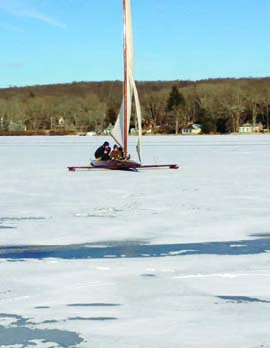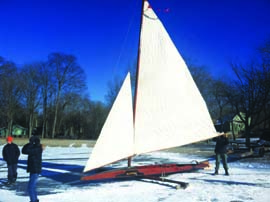Owned by Josh Welch of Stonington, CT, SLIPPER is an elegant Herreshoff iceboat. “SLIPPER is built of oak and mahogany,” said Welch. She’s 26 feet long and 13 ½ feet wide. She was designed in 1925 by L. Francis Herreshoff and built by him and W. Starling Burgess that winter in a shared shop in Marblehead, Massachusetts. She was built for Commodore Charles A. Welch, who was my great, great uncle. Charlie Welch was a good friend of L. Francis and his best client. In 1925, Herreshoff created three designs for Charlie: the R-boat Yankee, a lifeboat cruiser that was never built, and SLIPPER, the only iceboat that L. Francis designed professionally.”

SLIPPER’s owner Josh Welch and friends flirt with a flicker on Rogers Lake in Old Lyme, CT. © Dini Mallory
“I saw an article about SLIPPER in WoodenBoat [January/February 2005] and thought, ‘Boy, that’s neat.’ I called my Uncle Charlie, who’s named for Charlie Welch. He had also read the article and thought it was great, but we left it at that. I called Mark Mason, who co-owned SLIPPER with Nat Wilson, a sailmaker in East Boothbay, Maine who had built a new set of sails for her. I said, ‘Give me a call if you ever want to sell.’ Mark called a few years ago and said he’d love to sell her to me. I called Uncle Charlie back, and we picked her up at Nat’s loft.”
“Herreshoff was using materials that were new and different in 1925,” said Welch. “SLIPPER’s mast step is aluminum, which was an aircraft material that people were just beginning to play with. In 1927, Herreshoff received a patent for a fully-battened main, which was designed for this boat. There’s something social about this boat because you can get two or three people in her, and that’s fun. She’s a stern-steerer, and she has a different feel from most iceboats. Stern-steerers were known for ‘flickering,’ which is what happens when your stern rudder loses grip…they’ll just start spinning around.”
A little more than a century ago, Welch noted, iceboats were the fastest vehicles on earth. “They were doing 80 or 90 miles per hour on the Hudson River,” he said. “And with a boat that’s 88 years old, every once in a while something goes ‘boing!’ A year or two ago, I was sailing with my daughter in Massachusetts. Her GPS indicated that we were pushing 50, and then the traveler link snapped. The traveler was essentially two blocks held together with wire, and I subsequently had a friend weld a much stronger link.”

Rigging this classic Herreshoff ice yacht takes almost an hour, as does de-rigging, but a craft capable of sailing at three times the windspeed is worth the effort! © Rod Clingman
Welch makes such improvements with an eye on keeping SLIPPER as original as possible. “My friend Rod Clingman has a fantastic shop,” he said. “After we sailed her on a recent Saturday, Rod and I brought her to his shop on Sunday and made some adjustments. We looked at her and asked, ‘what would L. Francis do? Would he try to recreate things the way they were, or would he use the best materials he had on hand?’ We concluded that he probably would’ve done the latter!”




